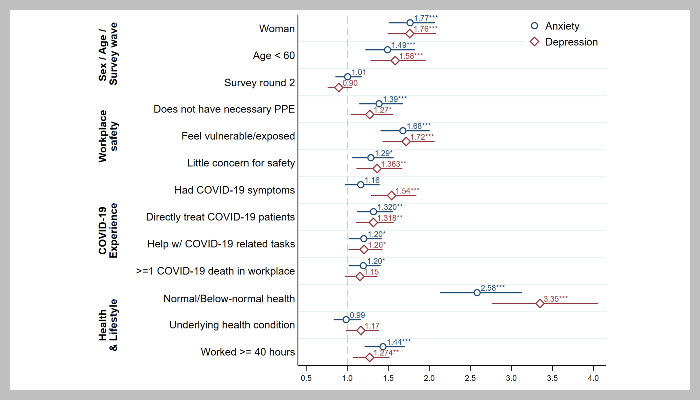Depression rife among medical doctors during pandemic
Published: 10 November 2021
High levels of anxiety and depression among medical doctors have been recorded in a new cross-country study involving the Institute's Dr Antonia Ho that finds Italian doctors most likely to have experienced mental health symptoms during the Covid-19 pandemic.

High levels of anxiety and depression among medical doctors have been recorded in a new cross-country study involving the Institute's Dr Antonia Ho that finds Italian doctors most likely to have experienced mental health symptoms during the Covid-19 pandemic.
The study, published in the peer-reviewed journal PLOS ONE, measured the mental wellbeing of doctors in Catalonia, Italy and the UK using over 5,000 survey responses gathered at two points of the pandemic, in June and November/December 2020.
It found that around one in four medical doctors in Italy had experienced symptoms of anxiety in June and December 2020, with around one in five reporting symptoms of depression over the same period.
In Catalonia, around 16 per cent of doctors reported anxiety and around 17 per cent depression symptoms during the same period.
In the United Kingdom, around 12 per cent of doctors reported anxiety and around 14 per cent depression symptoms.
The study is among the first cross-country analyses of mental wellbeing among healthcare workers during the COVID-19 pandemic and the first to focus on medical doctors – including consultants, specialty doctors and associate specialists (SASs), specialty registrars, junior doctors and general practitioners.
Across all countries, female doctors were more likely to have anxiety and depression symptoms. In Italy, there was a 60 per cent greater likelihood of female doctors reporting anxiety symptoms, and in the UK there was a 54 per cent greater prevalence of depression symptoms among female doctors.
Younger doctors (under 60) were more likely to experience anxiety and depression symptoms in each of the three countries, and a correlation was also found between perceptions of workplace safety and mental health.
Around half of Italian doctors disagreed with the statement ‘my workplace is providing me with the necessary PPE’ in June 2020, a figure that decreased to 30 per cent in December 2020.
This made Italy the country with both the lowest perceived workplace safety and highest rates of anxiety and depression.
Doctors from all three countries who felt vulnerable or exposed in their workplace all had greater odds of anxiety and depression symptoms.
Those who reported below normal health (below 3 on a 1-5 scale) had higher odds of anxiety and depression, and doctors who had worked 40 hours or more in the previous week also had higher odds of anxiety and depression.
Co-author of the study and principal investigator Climent Quintana-Domeque, Professor of Economics at the University of Exeter Business School, said the study can inform how to protect and promote the mental wellbeing of medical doctors in current and future pandemics.
Professor Quintana-Domeque said: “The COVID-19 pandemic has been classified as a traumatic event, with healthcare workers arguably having the most direct and longest exposure to this disease.
“Our study identified a high prevalence of anxiety and depression symptoms among medical doctors in both the first and second waves of the pandemic, and the similar patterns across countries suggest that our findings may be applicable to other European settings.
“The results of this study suggest that institutional support for healthcare workers, and in particular doctors, is important in protecting and promoting their mental health in the current and in future pandemics.”
Dr Ho, Consultant in Infectious Diseases at our Centre for Virus Research, said: "Our study confirms that a high proportion of doctors who responded to our survey in all three countries experienced symptoms of anxiety and depression.
"We identified a number of factors associated with poor mental health, including perceived low workplace safety, long working hours, lack of institution support and fear of infecting others.
"With ongoing pressure on health systems from COVID-19 in the background of significant disruptions to routine and emergency non-COVID health care, protecting the mental wellbeing of healthcare workers and addressing some of the identified drivers of anxiety and depression should be a top priority."
Professor Eugenio Proto from the Adam Smith Business School said: “This study confirms once more how Italy has been at the forefront in the fight against coronavirus, and paid a big toll that will probably be felt in the year to come.’’
Anxiety and depression among medical doctors in Catalonia, Italy, and the UK during the COVID-19 pandemic
- Climent Quintana-Domeque, Ines Lee, Anwen Zhang, Eugenio Proto, Michele Battisti, Antonia Ho
- Published: 2 November, 2021
Image Legend: Fig 4. Risk factors of anxiety and depression symptoms, odds ratios and 95% CI.
The figure displays the odds ratio of each variable (and its corresponding 95% CI) from a multivariable logistic regression pooling across all countries and timepoints. The dependent variables are binary indicators for anxiety (circle markers) or depression (diamond markers).
Enquiries: Clairelouise.smith@glasgow.ac.uk
First published: 10 November 2021

